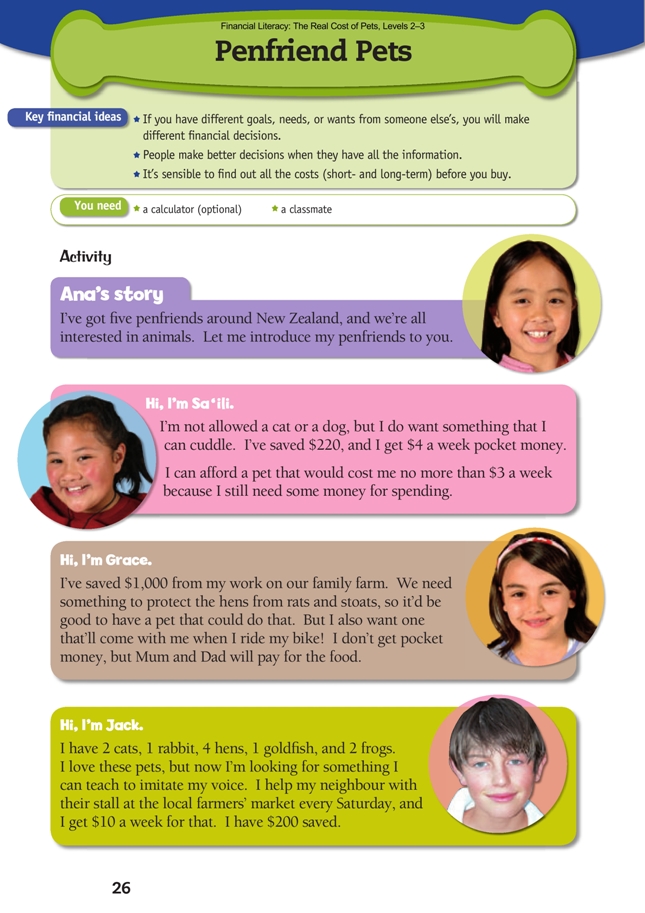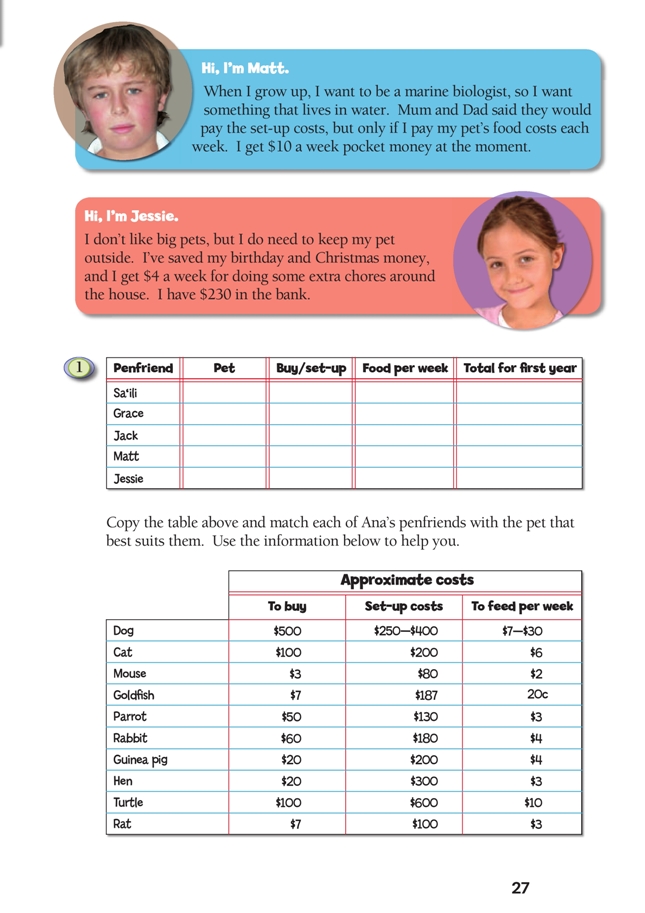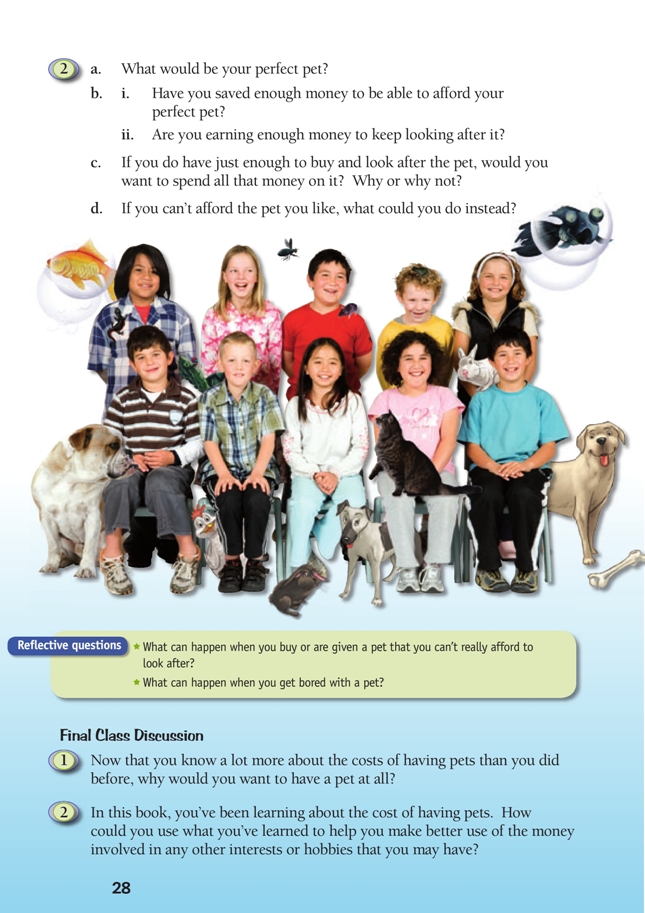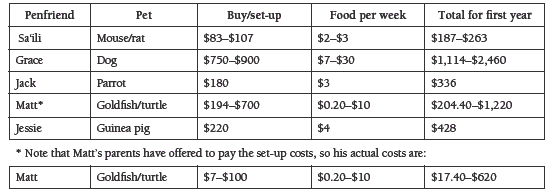This is a level 3 number and algebra activity and a level 2 statistics activity from the Figure It Out series. It relates to Stage 6 of the Number Framework.
A PDF of the student activity is included.
Click on the image to enlarge it. Click again to close. Download PDF (2201 KB)
use mental strategies to add costs
use multiplicative strategies to find yearly costs based on weekly costs
Number Framework Links
Students at stage 5 could work independently, using a calculator or other materials like money, after teacher explanation. Students at stage 6 should be able to use numeracy strategies to solve the problems independently. (See the table of NDP material on page 4.)
A calculator (optional)
A classmate
Financial understanding
This activity emphasises that people’s decisions differ because people have different preferences. Ana’s penfriends have different family situations, so they have different needs and wants, and no one pet is going to suit everybody.
The students are collecting, organising, and analysing information when they match the personal goals of Ana’s penfriends to the pet that would suit them best.
You may need to check that the students know what a penfriend is and the fact that they can be different ages and live in different cities or countries.
As this activity is at the end of the book, you could ask if anyone has recently got a new pet or if anyone has changed their mind, as a result of these inquiry learning activities, as to what kind of pet they would like to have if they could. Discuss the reasons why the students may not be able to have, short or long term, the pets they
would like to have (cost, allergies, limitations of the home environment, time to care for them properly, and so on). Have the students find photographs of people and discuss what pet the people in the story or photo might have and what their limitations might be in terms of being able to care for that pet. There are plenty of stories
and articles available in the School Journal to support this approach. Webquests that involve matching pets to people and environments are also available, for example, the students could search under “choosing a pet” or “choosing a pet + environment”.
Mathematics and statistics
For the activity itself, you need to ensure that the students are able to relate the information given by each penfriend to the table and that they can justify their choices of suitable pets. They also need to be clear on which parts of the information given they need to use to complete the “Total for first year” column.
Further tasks
The students could:
• write about the requirements of characters from a book study and have other students match an appropriate pet to that character
• contact the students in a school or class different from their own in terms of decile, location, size, or geographics and survey what pets those students own, how the pets are different, and why that would be the case
• investigate funding a child overseas or an organisation that supports needy children or adults (that is, people who not only cannot afford pets but who need help themselves to survive).
Social Sciences Links
Achievement objectives:
• Understand how people make choices to meet their needs and wants (Social Studies, level 2)
• Understand how cultural practices reflect and express peoples’ customs, traditions, and values (Social Studies, level 2)
The students could investigate what sort of pets people from other communities have or cannot have. They could then discuss what this might say about those communities, their customs, traditions, and values.
Other Cross-curricular Links
English achievement objective:
Purposes and Audiences: Show a developing understanding of how to shape texts for different purposes and audiences (Speaking, Writing, and Presenting, level 3)
The students could choose one of the characters described and write about what happens when they get their pet. This could also be done as a series of letters between themselves and Ana.
The students could write to or email a relation who doesn’t live nearby and ask them what pet they would like to own if they could, or if the relation is older, what pet they always wanted or enjoyed most when they were growing up.
Answers to Activity
1.
2. a.–b. Answers will vary.
c. Answers will vary. You would need to make sure unexpected costs can be covered. If there is no extra money to spare, then there is no money to save for these possible costs. Also, if all your money goes on your pet, you may grow to resent this.
d. Answers will vary. You will have to come to terms with not getting the pet you’d
really like to get and either get a different pet that you can afford or possibly look
for ways to earn the extra income needed. You might look for ways of helping people who do have the pets you like (this may or may not be paid time).
Reflective questions
• Answers will vary. You need to be aware that pets can suffer in this situation, and if this involves them not getting enough food or time spent on them, this can be very bad for their health or well-being. There are times when the SPCA takes away people’s pets because the pets have been badly neglected.
• You might have to give away your pet; it is not fair to expect your parents or other adults to take over the responsibility for your pets if you get bored.
Final Class Discussion
1. Discussion will vary. People choose to spend their money on pets because they are interested in watching them grow, they like watching them play, they enjoy interacting with them, they value the love, affection, friendship, and company they may get from the animal, and it’s also a way of meeting and talking to other
animal lovers. Remember, too, that most hobbies cost money and many of them have no return other than pleasure.
2. Discussion will vary. It may have given you a better understanding of the costs involved in playing sport, for example, especially at representative level, or in developing another interest or hobby. It may make you spend your money more wisely when buying equipment; you might look at earning some income from
your hobby, or you might decide that the enjoyment and challenges you get are worth the money you spend.



